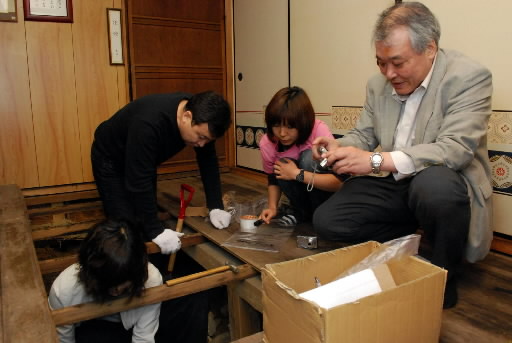Soil samples are collected to discern the area of "black rainfall"
May 28, 2010
by Junji Akechi, Staff Writer
On May 26, Professor Masaharu Hoshi and others at Hiroshima University's Research Institute for Radiation Biology and Medicine (RIRBM) collected soil samples from under floors of houses located in Asakita Ward, Hiroshima. They are seeking to discern the area of "black rainfall" by studying whether the soil contains radioactive material related to the black rain, which fell in the aftermath of the atomic bombing.
The team of four, led by Professor Hoshi, visited houses nearly 15 kilometers north of the hypocenter, an area where the black rain fell lightly. They collected the soil samples by driving a 30 centimeter-long metal cylinder into the ground. The team will study whether the samples contain Cesium 137, a byproduct of fission, by the end of this year.
Professor Hoshi and others launched the research in 2008. They are now analyzing 15 soil samples from houses built between 1945 and the end of 1948. The houses built between those years were chosen to avoid the influence of nuclear tests conducted by other countries after World War II. Among seven samples already analyzed, three samples show a high amount of radiation caused by black rain, measuring 10 to 60 mGy, nearly 10 to 60 times the maximum permissible level on an annual basis.
Professor Hoshi is continuing to seek houses at which to collect soil samples.
(Originally published on May 27, 2010)
Related articles
Radioactive materials contained in black rain detected outside the Health Examination Special Designated Area (Feb. 3, 2010)
Professor at Hiroshima University seeks soil under floors to discern area of "black rainfall" (Jan. 13, 2010)
On May 26, Professor Masaharu Hoshi and others at Hiroshima University's Research Institute for Radiation Biology and Medicine (RIRBM) collected soil samples from under floors of houses located in Asakita Ward, Hiroshima. They are seeking to discern the area of "black rainfall" by studying whether the soil contains radioactive material related to the black rain, which fell in the aftermath of the atomic bombing.
The team of four, led by Professor Hoshi, visited houses nearly 15 kilometers north of the hypocenter, an area where the black rain fell lightly. They collected the soil samples by driving a 30 centimeter-long metal cylinder into the ground. The team will study whether the samples contain Cesium 137, a byproduct of fission, by the end of this year.
Professor Hoshi and others launched the research in 2008. They are now analyzing 15 soil samples from houses built between 1945 and the end of 1948. The houses built between those years were chosen to avoid the influence of nuclear tests conducted by other countries after World War II. Among seven samples already analyzed, three samples show a high amount of radiation caused by black rain, measuring 10 to 60 mGy, nearly 10 to 60 times the maximum permissible level on an annual basis.
Professor Hoshi is continuing to seek houses at which to collect soil samples.
(Originally published on May 27, 2010)
Related articles
Radioactive materials contained in black rain detected outside the Health Examination Special Designated Area (Feb. 3, 2010)
Professor at Hiroshima University seeks soil under floors to discern area of "black rainfall" (Jan. 13, 2010)








